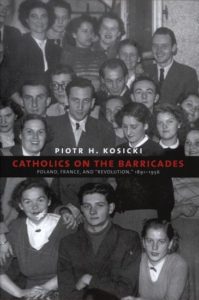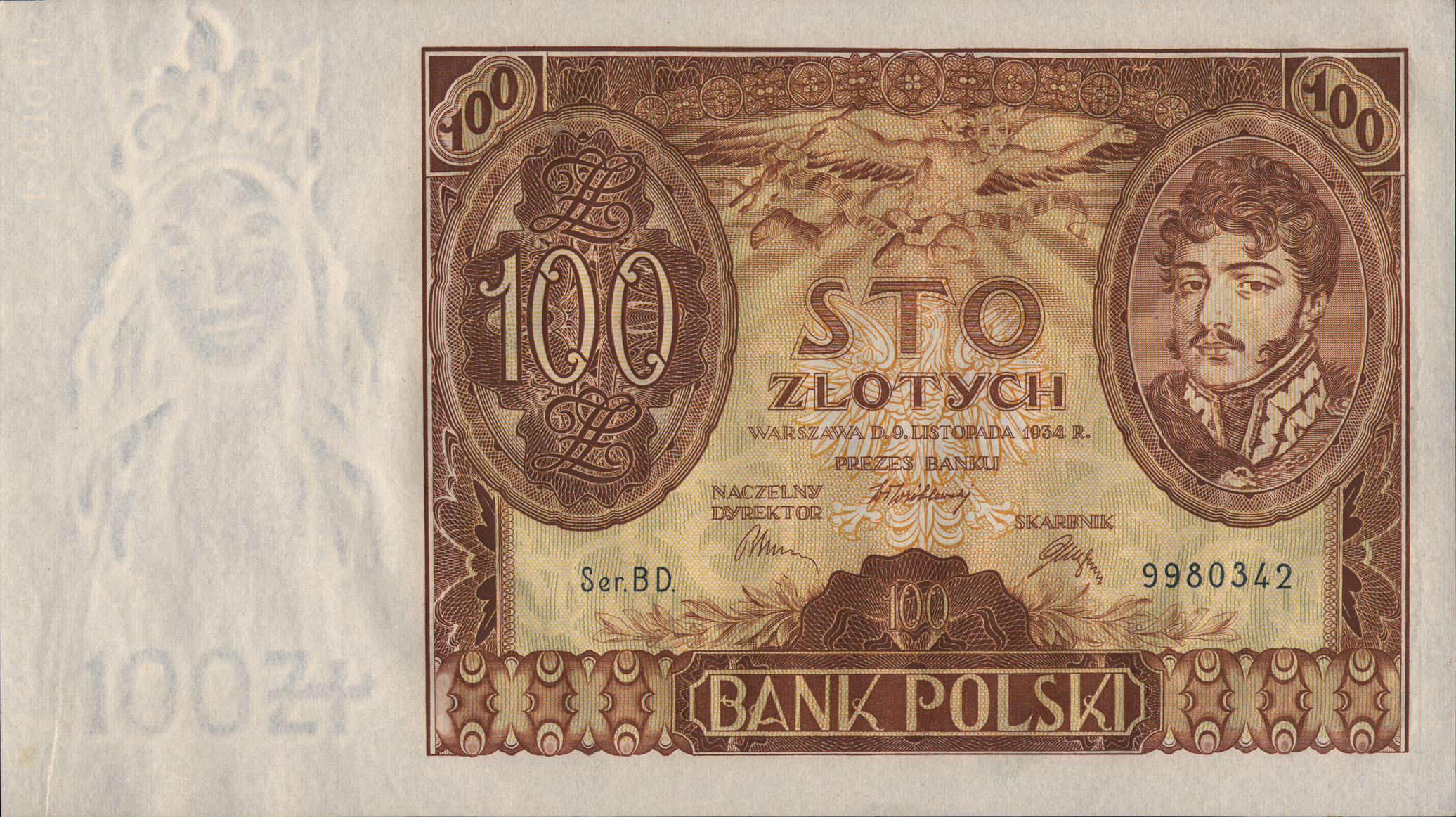The suggestive image of an “Iron Curtain” creating an airtight separation of East and Central Europe from the western part of the continent often prevent us from taking note of exchanges which took place across the divide from Szczecin to Trieste. Similarly, if we examine Cold War intellectual history, we tend to look on the dominant currents on both sides of the divide, than focus on the margins of intellectual life. For these two reasons, Piotr Kosicki’s attempt to reconstruct Catholic socialism in Poland in the light of exchanges taking place between Poland and France in the post-war period, deserves particular attention.
by Przemysław Pazik

Piotr H. Kosicki
Yale University Press
424 pages, 6 1/8 x 9 1/4
13 b/w illus.
ISBN: 9780300225518
Hardcover
Catholics on the Barricades is an original and engaging study of the “revolutionary” tradition of Polish and French Catholicism. It was a radical response to the encyclical of Pope Leo XIII Rerum novarum, ultimately banned from Catholic orthodoxy in the mid 1950s. It returned under a new disguise during the Second Vatican Council and the post council era. According to the author’s own words, the book tells the story of “the radicalisation and deradicalisation (…) of European intellectuals, whose fin-de-siècle and interwar educations took on new meaning in the resistance to Nazism”. The process set in motion by Catholic radicals, Kosicki argues, culminated in Polish and European events of the 1980s: the election of John Paul II, the protests of dockyard workers in Gdańsk and Szczecin and the peaceful Polish revolution that followed in 1989. In other words, Kosicki’s ambition was to reveal the intellectual genealogy of “open” Polish Catholicism.
The author makes a worthwhile argument that the road to John Paul II’s Victory Square homily in 1979 and the protests a year after, led through Paris, and more precisely, through the studios and salons of Jacques Maritain and Emmanuel Mounier. The concepts of “human person” and “Christian revolution” elaborated by them in the 1930s became the central terms of the Catholic discourse in Poland in the aftermath of the Second World War. This conceptual revolution was coupled with a sociological one: an undoubted merit of the book is showing that in post World War II Poland the Catholic elites from the interwar period were replaced by new, radical and personalist elites. These new elites – Kosicki continues – established direct contact with French Catholic revolutionaries under the leadership of Emmanuel Mounier.
In order to link the debates from 1940s and 1950s with the transition four decades later, Kosicki reconstructs in detail the process of this elite changeover. Starting from the interwar period, he argues that already in the early 1930s the ideas of Mounier and Maritain were read closely by Polish catholic intellectuals and while personalism did not become an official doctrine of political Catholicism, in certain milieus it played a dominant role. Moving to the occupation period (1939–1945), Kosicki is right to emphasise the popularity of the French philosophers among Polish left-leaning democratic intelligentsia. However, there is a drawback to the author’s method. While searching for Mounier and Maritain’s readers, Kosicki points to groups which did not associated themselves with Catholicism and he does not analyse the programmatic and ideological output of the “Union” — a clandestine organisation which in 1943 merged with Christian democrats from the Labour Party (Stronnictwo Pracy). In consequence, the reader is presented with a map of political personalism (and not political Catholicism) in occupied Poland.
At the heart of Kosicki’s work is a meticulous reconstruction of the political process and ideological debates of the post-war period. Four out of eight chapters focus exclusively on the decade from the end of the war to Gomułka’s return to power in 1956. First, the author makes a case for the “twilight of social Catholicism”: the political and ideological disintegration of Polish Christian democrats in 1947 and their imprisonment a year after. Secondly, Kosicki shifts focus on the French counterparts of Polish Catholic intellectuals and presents Mounier’s dilemma: should he support his pre-war followers in their quest for a non-political, social engagement of Catholics who coalesced in the publications Tygodnik Powszechny and Znak, or rather should he align with ex-nationalists from PAX led by Bolesław Piasecki. Kosicki convincingly argues that it was the social radicalism and political activism of the latter group that won the Frenchman’s support, leaving Turowicz and Stomma embittered and excluded from international Catholic exchanges until 1956.
The Stalinist turn in Polish politics in 1948, marked by the unification of the Communist and Socialist parties, also had a major impact on the Catholic scene. The PAX Association openly supported socialism as the only valid political ideology and called the faithful in Poland to follow the leadership of the Communist government. Kosicki might have gone too far in suggesting that Piasecki was the leading negotiator of the modus vivendi between the Church and the state signed in 1950. By elevating Piasecki to the role of chief negotiator, the American scholar downplayed the role of the official Church intermediaries: Bishops Choromański, Zakrzewski and Klepacz. Interestingly, portraying Piasecki as one of the architects of the 1950 agreement did not prevent Kosicki from rightfully noting that the public condemnation of Primate Stefan Wyszyński and Bishop Kaczmarek (both arrested in 1953) in the PAX press meant the definitive split between PAX and the Catholic hierarchy.
The final chapters of the book are entirely dedicated to the international and domestic dimensions of PAX’s activism. Regarding the former, Kosicki shows how the key persons from Piasecki’s entourage worked to form a Catholic-socialist international. At the zenith of Stalin’s dominion over Eastern Europe, PAX members organized and incited anti-Americanism within the framework of the peace movement formed in the wake of the Stockholm appeal in 1950. While appreciating the resourcefulness of Polish Catholics, Kosicki seems to ignore the crucial question: were the intentions of Polish Catholic socialists genuine or was it only a ploy to break Catholic anticommunism?
Overall, the author’s reading of PAX’s role in Polish politics is surprisingly positive. He limits himself to taking note of the far-right ideology of Piasecki and his followers before 1939 without proposing an explanation as to how former fascists became advocates of Catholic socialism. Nor does the author openly confront the question of the relations between Piasecki and Ivan Serov – a high ranking KGB officer, and from March 1945 the chief advisor to the Minister of Public Security in Poland.
Instead, Kosicki argues that despite its part in strengthening communist rule, Piasecki’s association was instrumental in creating space for young catholic leaders: Mazowiecki (future democratic prime minister in 1989) and Zabłocki. The author argues that contrary to the PAX old guard, whose Catholic-socialists beliefs might have been an effect of realist calculation, and not a sincere conviction, Mazowiecki and Zabłocki took Mounier’s ideas seriously. This difference, Kosicki believes, was the reason of the split within PAX in 1955.
To conclude, the most innovative and debatable aspect of Kosicki’s book is putting the PAX movement in the centre of Polish Catholic politics of the 1940s and 1950s. The value of this approach lies in reconstructing transnational networks of the followers that Piasecki managed to establish. Furthermore, in opposition to most the scholarship, the author took PAX’s ideology seriously. This allowed him to count former Polish radical right-wingers in the ranks of the post-war left leaning followers of Mounier. Consequently, the fall of PAX is linked with the Vatican’s crackdown on Catholic socialists in France and other parts of Europe.
Kosicki concludes his work by arguing that Polish political Catholicism from the late 1970s and 1980s had a two-fold genealogy: on one hand it stemmed from the “neopositivism” and political realism of Tygodnik Powszechny, on the other, however, it was motivated by a desire to transcend the Catholic socialist legacy of PAX’s political engagement from the 1950s. It is hard to fully share Kosicki’s view on PAX’s ideological and political autonomy and therefore to see it as a constructive and innovative force within Polish Catholicism. However, the book makes a strong case for claiming that Polish “open Catholicism” was in fact a part of a pan-European trend of “Left Catholicism” — a term proposed in 2001 by two scholars of western Catholicism: Gerd Rainer Horn and Emmanuel Gerard. This is enough to consider Catholics on the Barricades a needed and important work: an invitation to explore transnational contexts of Polish Catholicism and to go beyond national and linguistic barriers towards a global perspective on Polish and Catholic history.
Author: Przemysław Pazik





